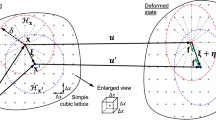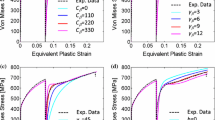Abstract
The essential work of fracture concept has been extended to cover ductile tearing of polymeric materials that neck before fracture. It is shown that the plane stress specific essential fracture work (w e) can be obtained from deeply edge-notched tension specimens, containing either single or double notches, by extrapolating the straight line relationship between the total specific fracture work (w f) and ligament length (l) to zero ligament. In this way, specific essential fracture works have been obtained for nylon 66 and two polyethylenes. It seems that w eis a material property for a given sheet thickness being independent of specimen geometry. The straight line relationship between w fand l breaks down when the ligament length to sheet thickness ratio is less than about three, since the fracture data fall in the plane stress-plane strain transition region. However, a plane strain specific essential fracture work can still be obtained by extrapolating the least squares curve of the data to zero ligament provided the thickness satisfies plane strain condition. If this condition is not satisfied a near plane strain value is obtained which is dependent upon thickness. This method is also appropriate for ductile polymers like the rubber modified polystyrenes that craze rather than neck.
J Rcurves have also been obtained for nylon 66 and the polyethylenes. Under strictly J-controlled crack growth conditions, it is shown that the intercept and slope of the J Rcurve, i.e. J cand dJ/da, are related to the intercept and slope of the w fversus l plot. The limited amounts of J-controlled data available have precluded a more definite and general conclusion to be made. But based on what little is available, the comparisons of these two quantities in the J R-Δa and w f-l plots are not unreasonable.
Résumé
On a étudié le concept de travail essentiel de rupture pour couvrir l'arrachement ductile des matériaux polymères qui sont sujets à striction avant la rupture. On montre que le travail essentiel de ruptures (We) spécifique à l'état plan de tension peut être obtenu dans le cas d'éprouvettes de traction à entaille latérale profonde comportant une ou deux entailles, en extrapolant la relation linéaire qui lie le travail total de rupture (Wf) et la longueur de ligament (l) jusqu'à un ligament nul. De la sorte, on a obtenu le travail essentiel de rupture pour du nylon 66 et pour deux poly-éthylènes. I1 semble que We est une propriété du matériau pour une épaisseur de plaque donnée, qui est indépendante de la géométrie de l'éprouvette. La relation linéaire entre Wf et l par par un point de rebroussement lorsque le rapport de la longueur du ligament à l'épaisseur de la tôle devient inférieur à environ trois, ce qui correspond au passage des données de rupture dans la transition contrainte plane-déformation plane. Néanmoins, on peut encore obtenir un travail essentiel de rupture spécifique à l'état plan de déformation en extrapolant par les moindres carrés les données jusqu'à un ligament nul, pour autant que l'épaisseur satisfasse un état plan de déformation. Si cette condition n'est pas satisfaite, on obtient une valeur pour un état voisin de l'état plan de déformation, qui dépend de l'épaisseur. Cette méthode est également utilisable dans le cas des polymères ductiles qui, tels les polistyrènes de la famille des caoutchoucs, sont sujets à effritement.
Similar content being viewed by others
References
J.G. Williams, Fracture Mechanics of Polymers, Ellis Horwood/John Wiley, Chichester, U.K. (1984).
A.G. Atkins and Y.-W. Mai, Elastic and Plastic Fracture: Metals, Polymers, Ceramics, Composites, Biological Materials, Ellis Horwood/John Wiley, Chichester, U.K. (1985).
E.H. Andrews, Fracture in Polymers, Oliver and Boyd, England (1968).
B.R. Lawn and T.R. Wilshaw, Fracture of Brittle Solids, C.P.U., England (1975).
B. Cotterell and J.K. Reddell, International Journal of Fracture 13 (1977) 267–277.
B. Cotterell, in Fracture Mechanics and Technology (eds.) G.C. Sih and C.L. Chow, Vol. 2, Sijthoff and Noordhoff, Alphen aan den Rijn (1977) 785–795.
B. Cotterell and Y.-W. Mai, in Advances in Fracture Research, (ed.) D. Francois, Vol. 4, Pergamon Press, Oxford (1981) 1683–1695.
Y.-W. Mai and B. Cotterell, Engineering Fracture Mechanics 21 (1985) 123–128.
B. Cotterell, E. Lee and Y.-W. Mai, International Journal of Fracture 20 (1982) 243–250.
Y.-W. Mai and B. Cotterell, International Journal of Fracture 24 (1984) 229–236.
J.M. Hodgkinson and J.G. Williams, Journal of Materials Science 16 (1981) 50–56.
E.H. Andrews and Y. Fukahori, Journal of Materials Science 12 (1977) 1307–1319.
C. Gurney and J. Hunt, Proceedings, Royal Society, London A 299 (1967) 508–524.
C. Gurney and Y.-W. Mai, Engineering Fracture Mechanics 4 (1972) 853–863.
Y.-W. Mai and W.K. Cheng, to be published.
Y.-W. Mai and B. Cotterell, Journal of Materials Science 15 (1980) 2296–2306.
J.R. Rice, in Fracture (ed.) H. Liebowitz, Vol. 2 Academic Press, New Youk (1968) 192–308.
Y.-W. Mai and J.G. Williams, Journal of Materials Science 12 (1977) 1376–1382.
R. Horlyck, B.E. Thesis, Department of Mechanical Engineering, University of Sydney, Australia (1984).
G. Vigna, B.E. Thesis, Department of Mechanical Engineering, University of Sydney, Australia (1983).
R.P. Burford, R.P. Chaplin, M. Pittolo and Y.-W. Mai, Journal of Materials Science Letters 5 (1986) 57–59.
O.F. Yap, Y.-W. Mai and B. Cotterell, Journal of Materials Science 18 (1983) 657–668.
O.F. Yap, Ph.D. Thesis, Department of Mechanical Engineering, University of Sydney, Sydney, Australia (1982).
J.A. Nairn, Private communication (July 1985).
J.W. Hutchinson and P.C. Paris, in Elastic-Plastic Fracture, ASTM STP 668 (1979) 37–64.
P.C. Paris, H. Tada, A. Zahoor and H. Ernst, in Elastic-plastic Fracture, ASTM STP 668 (1979) 5–36.
J.A. Begley and J.D. Landes, in Fracture Toughness, ASTM STP 514 (1972) 1–23.
B. Cotterell, Y.-W. Mai and R.M.L. Foote, in Proceedings Conference on Engineering Applications of New Composites, Patras, Greece (1986) to be published.
Author information
Authors and Affiliations
Rights and permissions
About this article
Cite this article
Mai, YW., Cotterell, B. On the essential work of ductile fracture in polymers. Int J Fract 32, 105–125 (1986). https://doi.org/10.1007/BF00019787
Received:
Revised:
Issue Date:
DOI: https://doi.org/10.1007/BF00019787




